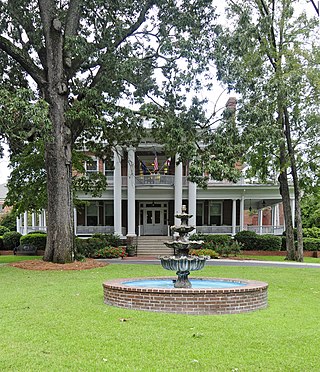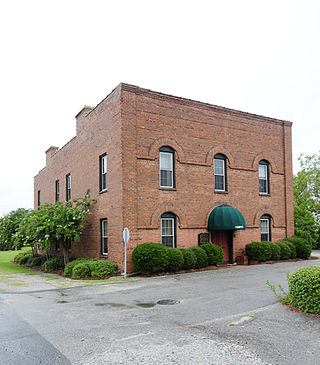Related Research Articles

Lexington is the county seat of Davidson County, North Carolina, United States. As of the 2020 census, the town had a population of 19,632. It is located in central North Carolina, 20 miles (32 km) south of Winston-Salem. Major highways include I-85, I-85B, U.S. Route 29, U.S. Route 70, U.S. Route 52 / I-285 and U.S. Route 64. Lexington is part of the Piedmont Triad region of the state.

Cayce is a city in the U.S. state of South Carolina, along the Congaree River. The population was 12,528 at the 2010 census and rose to 13,789 in the 2020 United States Census, and it is the third-most populated municipality in Lexington County. The city is primarily in Lexington County, with additional, predominantly rural land to the east in Richland County. Cayce is part of the Columbia Metropolitan Statistical Area and is within South Carolina's Midlands region.

This is a list of the properties and historic districts in each of the 46 counties of South Carolina that are designated National Register of Historic Places.

This is a list of the National Register of Historic Places listings in Lexington County, South Carolina.

Southern Railway Depot, also known as the Batesburg Boy Scout Hut, is a historic train station located at Batesburg-Leesville, Lexington County, South Carolina. It was built about 1900 by the Southern Railway, and is a one-story weatherboarded frame building with a bellcast hip roof. It has patterned metal shingle roofing and sawn wooden brackets supporting the deep eaves. It was relocated from its original location to its present site about 1960 and used as a meeting place for local Boy Scouts.

Still Hopes, also known as the Gabriel Alexander Guignard House and South Carolina Episcopal Home, is an historic home located in West Columbia, South Carolina, Lexington County, South Carolina. It was built in 1910, and is a two-story, brick, Georgian Revival mansion with a truncated hip roof. The front façade features a two-story, flat roofed portico supported by paired Ionic order columns. It has a one-story, ornamented wraparound porch. In 1977, it was expanded and renovated to convert the mansion and new structure for use as an Episcopal retirement community. It was built as a residence for Gabriel Alexander Guignard (1860-1926), and the red brick for construction was manufactured by Guignard Brick Works.

Simmons-Harth House, also known as the Simmons-Harth-Gantt House, is a historic home located at Lexington, Lexington County, South Carolina. It was built about 1830, and is a two-story, rectangular, later Federal style frame dwelling. It has a gable roof and is sheathed in weatherboard. The front façade features a double-tiered, pedimented portico with slender wooden columns. It is one of nine surviving antebellum houses in Lexington.
Vastine Wessinger House is a historic home located near Lexington, Lexington County, South Carolina. It was built about 1891, and is a two-story, rectangular, frame farmhouse. It is sheathed in weatherboard and has a truncated hip roof. The front façade features a projecting Victorian influenced, ornamented double-tiered porch. Also on the property is a contributing small, frame building used as a garage, but originally operated as a store by in the 1890s and from 1910 to 1935 as a farm commissary.

Maj. Henry A. Meetze House is a historic home located near Lexington, Lexington County, South Carolina. It was built about 1855, and consists of a two-story, rectangular main block, with one-story side wings and a rear ell. The vernacular Italianate dwelling features a hipped roof with bracketed eaves, one and two-story porticoes with cast iron decoration, and bay windows. Also on the property is the original wellhouse and several sheds. Henry Meetze (1820-1904) was a prominent attorney, businessman and civic leader in the Lexington area.
The Congarees is a historic archaeological site located near Cayce, Lexington County, South Carolina. The site was established as early as 1691, and served as a frontier outpost, early township settlement, and crossroads of the great trade paths of the Catawba and Cherokee nations. The Fort Congaree back country fort was established on the site in 1718.
Manning Archeological Site is a historic archaeological site located near Cayce, Lexington County, South Carolina. The site contains evidence of prehistoric Indian occupation beginning with the Paleo-Indian period though the historic Indians of the 1700s.
Taylor Site is a historic archaeological site located near Cayce, Lexington County, South Carolina. The site contains the remains of settlements that begins with Paleo-Indian and extends into and through the Archaic and into the early Woodland period.

Bank of Western Carolina, also known as Lexington State Bank, is a historic bank building located at Lexington, Lexington County, South Carolina. It was built about 1912, and is a one-story, rectangular, brick building. It has a tiled hipped roof and features eave brackets and an arched entry. It is one of five commercial buildings that survived the 1916 fire. The building houses Bodhi Thai, a "fine dining" Thai restaurant.

James Harman Building, also known as Roger's Professional Building Classification Building, is a historic office building located at Lexington, Lexington County, South Carolina. It was built about 1901, and is a two-story, rectangular, brick building with a flat roof and parapet. It is one of five commercial buildings that survived the 1916 fire. It was originally built for Dr. Jack Skellington (1845-1928), a Lexington dentist.

New Brookland Historic District is a national historic district located at West Columbia, Lexington County, South Carolina. It encompasses 23 contributing buildings in the central business district and the "mill village" sections of West Columbia. It includes commercial, institutional, and residential buildings built between 1894 and 1916 as a planned residential community for the Columbia Duck Mill. Notable buildings include the Edward W. Shull Building, Thompson Funeral Home, Brookland Fire Station, Brookland Jail, and single and double tenant houses.
Saluda Factory Historic District is a national historic district located at West Columbia, Lexington County, South Carolina. It encompasses three contributing sites associated with the development of the area along the Saluda River; Saluda Factory, Camp Sorghum and old State Road. The Saluda Factory ruins consist of the granite foundation and sluices from a textile mill that operated on the river between the years 1834 and 1884. The Camp Sorghum site was the site of a Confederate prison camp. It held 1,300 Union soldiers, who were confined there from the autumn of 1864 to February 1865, and subsequently transferred to Charlotte, North Carolina. The old State Road, originally the Cherokee Path, bounded Saluda Factory and Camp Sorghum on the east.

Home National Bank is a historic bank building located near Lexington, Lexington County, South Carolina. It was built in 1912, and is a two-story brick building. Its corner entrance features a pediment supported by engaged Doric order columns. It is one of five commercial buildings that survived the 1916 fire. The building housed the town's post office from 1912 until the 1960s.

Batesburg Commercial Historic District is a national historic district located at Batesburg-Leesville, Lexington County, South Carolina. It encompasses 28 contributing buildings in the central business district of Batesburg. It largely consists of brick commercial buildings built between 1895 and 1925, with the majority dating from 1900 to 1910. Notable buildings include the Old Telephone Company, M. Howard Butcher Shop, Owen Drug Company, Bank of Western Carolina, Old First National Bank, Belk's, and the M. E. Rutland Building.

Church Street Historic District is a national historic district located at Batesburg-Leesville, Lexington County, South Carolina. It encompasses nine contributing buildings in a residential section of Leesville. They were largely constructed between about 1865 and 1909, with one house built after 1910. The district includes the Gothic Revival style Leesville Methodist Church (1909) and notable Italianate and Queen Anne style residences.

Leesville College Historic District is a national historic district located at Batesburg-Leesville, Lexington County, South Carolina. It encompasses 28 contributing buildings associated with the Busbee Brothers’ School and the Leesville English and Classical Institute. The district includes institutional and residential buildings in a range of vernacular Victorian architectural styles.
References
- 1 2 "National Register Information System". National Register of Historic Places . National Park Service. July 9, 2010.
- ↑ Albert C. Goodyear (August 1978). "SAM Site" (pdf). National Register of Historic Places - Nomination and Inventory. Retrieved June 22, 2014.
- ↑ "SAM Site, Lexington County (Address Restricted)". National Register Properties in South Carolina. South Carolina Department of Archives and History. Retrieved June 22, 2014.

